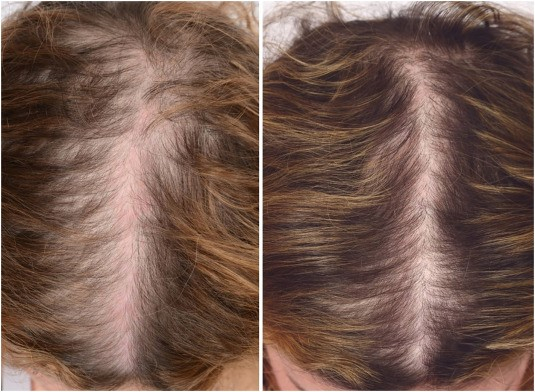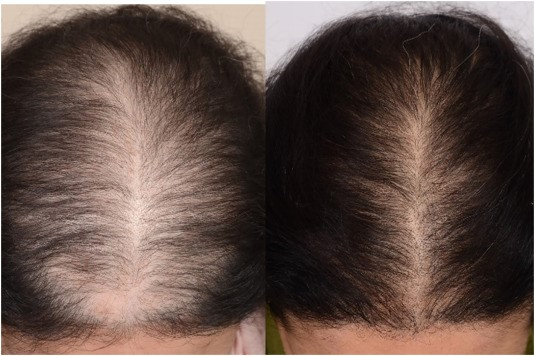Androgenetic alopecia, or female pattern baldness (AA), is hair loss caused by genetic and hormonal factors, which is characterized by an androgen-related progressive decrease in scalp hair density. By age 60, the disease affects 45% of men and 35% of women. Currently, oral finasteride and topical minoxidil are FDA approved for the treatment of androgenetic alopecia. However, their limited effectiveness necessitates the search for new treatments for AA. One of them is PRP therapy, which is discussed in the estet-portal.com article by doctors J. Stevens and S. Khetarpal.
- Available treatments for androgenetic alopecia
- Mechanism of action of PRP therapy in the treatment of alopecia
- Proposed protocol for the treatment of androgenetic alopecia with PRP therapy
Available treatments for androgenetic alopecia
Alopecia reduces the quality of life of patients, causing psychological and emotional discomfort. Effective and safe treatment of this disease can significantly improve the condition of patients.
Available treatments for androgenetic alopecia include:
- minoxidil;
- finasteride;
- spironolactone;
- nutritional supplements;
- low intensity light therapy;
- surgical hair transplantation.
While topical minoxidil and oral finasteride are FDA-approved for the treatment of androgenetic alopecia, these drugs demonstrate limited clinical effectiveness in some patients.
Benefits of PRP therapy for the treatment of androgenetic alopecia:
- autologous;
- minimal invasiveness;
- no risk of serious side effects;
- greater availability (in comparison with transplantation).
Mechanism of action of PRP therapy in the treatment of alopecia
During the wound healing process, activated platelets release growth factors and cytokines from alpha granules. These substances take part in:
- activation of fibroblasts;
- collagen synthesis;
- stimulation of the extracellular matrix;
- increasing the expression of endogenous growth factors.
Subscribe to our channel on Telegram !
Cellular proliferation, differentiation, angiogenesis and hemostasis necessary for hair regrowth are facilitated by :
- platelet growth factor;
- transforming growth factor beta;
- vascular endothelial growth factor;
- epidermal growth factor;
- insulin-like growth factor-1.

Photo 1: woman, 46 years old, before and 3 months after 2 sessions of PRP therapy for the treatment of androgenetic alopecia
IGF-1 has been found to induce and prolong the anagen phase. Platelets also contain dense granules containing bioactive factors that increase membrane permeability and modulate inflammation:
- serotonin;
- histamine;
- dopamine;
- calcium;
- adenosine
The exact mechanism of action of PRP in alopecia is not fully understood. However, PRP is thought to influence the hair growth cycle by prolonging the anagen phase, preventing apoptosis and the onset of the catagen phase, and accelerating the transition from telogen to anagen phase.
Many studies demonstrate the effectiveness of PRP in the treatment of androgenetic alopecia.
Angiogenesis and increased vascularization of the follicle are considered critical for the initiation of the anagen phase. On the contrary, androgenetic alopecia is characterized by poor blood circulation and decreased oxygen pressure.
The growth factors in PRP act on stem cells in hair follicles to promote neovascularization and folliculogenesis. There is also an increase in the expression of beta-catenin , which enhances the proliferation and survival of papillary cells dermis and angiogenesis.
Proposed protocol for the treatment of androgenetic alopecia using PRP therapy
Based on their own experience, the authors recommend the use of PRP as an adjuvant therapy for AA along with topical and/or oral therapy (eg, minoxidil, spironolactone, finasteride) because PRP does not suppress the hormonal component of androgenetic alopecia.
Read also: PRP therapy against aging hands: the possibilities of platelet-rich plasma
Based on the studies reviewed, the authors recommend preparing PRP by one-turn centrifugation to obtain pure PRP that has platelet concentrations 3 to 6 times the average blood concentration and to minimize the number of granulocytes.

Photo 2: woman, 31 years old, before and 4 months after 5 sessions of PRP therapy for the treatment of androgenetic alopecia
Most successful studies have added an activator (calcium chloride or calcium gluconate) to PRP, which can promote the release of growth factors.
The authors recommend administering PRP via subdermal bolus injections as this technique is less painful and generally more effective. The creation of subdermal depots ensures the diffusion of PRP and reduces the number of injections. The injection points are located in the area of baldness, usually along the hairline, on the crown, crown.
Course of procedures:
During the first 3 months, PRP therapy is carried out every 4 weeks, and then every 3 months during the first year of treatment (6 sessions in the first year - at 1, 2, 3, 6, 9 and 12 months).
You may also be interested in: Plasmolifting – scope of application and main advantages
However, after the first 3 months of therapy, the interval between PRP treatments may be 6 months.
Both men and women have had positive results from treating androgenetic alopecia with PRP therapy:
- restoration of hair growth;
- increase in hair density;
- improving quality of life.
PRP therapy is a promising treatment for androgenetic alopecia , according to research results. Its main advantages are high safety, minimal side effects and a short rehabilitation period. However, the preparation method, dosage of platelet-rich plasma, as well as the administration technique, number of procedures and interval between them are not standardized. Therefore, there is a need for further research.
Based on materials from the International Journal of Women's Dermatology.
More interesting videos on our YouTube channel!







Add a comment